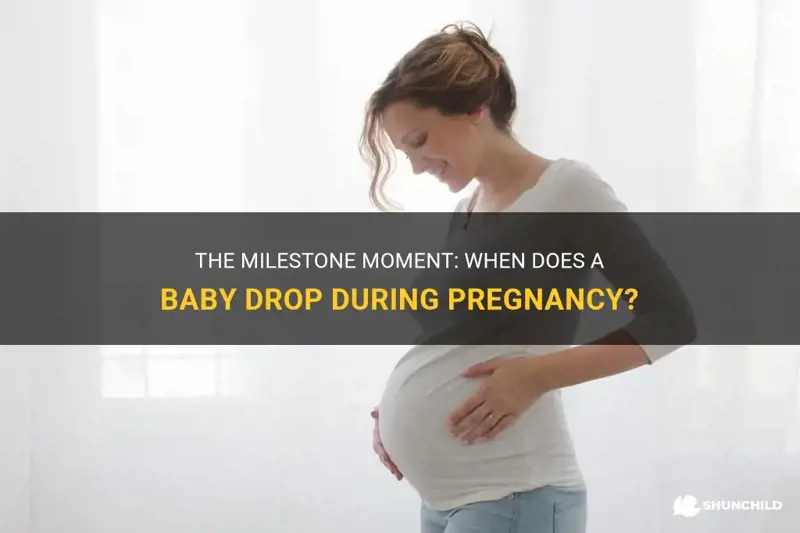
During the journey of pregnancy, there are various changes that occur in a woman's body. One of the notable and exciting transformations is when the baby drops, also known as lightening or engagement. This occurrence typically takes place towards the end of the third trimester, marking a significant milestone as the baby's position changes in preparation for birth. Understanding when this drop happens can provide valuable insights into the upcoming arrival of a little one, as well as the physical and emotional changes that come with it.
| Characteristics | Values |
|---|---|
| Position of the baby | Lower |
| Appearance | Round |
| Belly shape | Pointed |
| Easier breathing | Yes |
| Reduced heartburn | Yes |
| Increased pelvic pressure | Yes |
| More frequent urination | Yes |
| Difficulty walking | Yes |
| Lightening sensation | Yes |
| Increased vaginal discharge | Yes |
What You'll Learn
- What is meant by baby dropping during pregnancy?
- What are the typical signs and symptoms of baby dropping?
- At what stage of pregnancy does a baby usually drop?
- Are there any complications or risks associated with a baby dropping during pregnancy?
- How does the process of baby dropping relate to the onset of labor?

What is meant by baby dropping during pregnancy?
During the later stages of pregnancy, a common occurrence called "baby dropping" often takes place. This phenomenon, also known as lightening or engagement, refers to the movement of the baby's head downward into the pelvis in preparation for birth. Let's delve deeper into what is meant by baby dropping during pregnancy.
When baby dropping occurs, the baby's head aligns itself lower in the mother's pelvis. This can happen weeks or even just a few days before labor starts. The descent of the baby into the pelvis can be felt by the mother as a noticeable shift in her body.
The process of baby dropping serves several important purposes. First, it helps the baby position themselves for a smooth passage through the birth canal. By descending into the pelvis, the baby's head can engage with the cervix and put pressure on it, encouraging it to soften and dilate.
Furthermore, baby dropping aids in relieving some of the pressure on the mother's diaphragm and stomach. As the baby moves lower, it makes more room for the mother’s lungs and stomach, alleviating some of the common discomforts of late pregnancy like shortness of breath and heartburn.
There are a few indicators that can help a mother determine if her baby has dropped. These include:
- Changes in the shape of the belly: When a baby drops, the belly may appear lower and more elongated. The mother may also notice that her baby bump has shifted downward.
- Easier breathing: As the baby moves lower, the pressure on the mother's diaphragm and lungs is reduced, making it easier for her to breathe.
- Increased pelvic pressure: The mother may experience increased pressure and discomfort in her pelvic region as the baby's head engages with the pelvis.
- Increased urination frequency: When the baby's head exerts pressure on the bladder, the mother may feel the need to empty her bladder more frequently.
- Possible changes in gait: Some women may notice changes in the way they walk or move as the baby drops lower.
It's important to note that not all women will experience baby dropping in the same way. Some may not notice any significant changes until the onset of labor, while others may experience a gradual descent over a period of weeks.
If a woman is experiencing baby dropping, it is not a cause for immediate concern unless accompanied by other signs of preterm labor, such as regular contractions or vaginal bleeding. However, it is always best to consult with a healthcare provider if there are any concerns or unusual symptoms.
In conclusion, baby dropping during pregnancy refers to the movement of the baby's head downward into the pelvis as it prepares for birth. This process can provide relief to the mother and facilitate a smoother delivery. While the signs of baby dropping may vary, it is typically a normal and natural part of the later stages of pregnancy.
Will Vibrations Harm My Baby During Pregnancy?
You may want to see also

What are the typical signs and symptoms of baby dropping?
As your pregnancy progresses, you may start to notice some changes in your body as your baby prepares for birth. One of these changes is the baby dropping, also known as lightening or engagement. This occurs when your baby's head settles lower into your pelvis in preparation for delivery. Here are some typical signs and symptoms of baby dropping that you may experience:
- Changes in your breathing: When your baby drops, it can relieve pressure on your diaphragm and allow you to breathe more easily. You may notice that you can take deeper breaths and feel less short of breath.
- Increased pelvic pressure: As your baby descends into your pelvis, you may feel increased pressure in your lower abdomen and pelvic area. This can be uncomfortable and may cause you to feel like you constantly need to urinate.
- Changes in your walking pattern: With the baby's head lower in your pelvis, you may notice that your gait changes. You may waddle or feel like you are walking with your legs further apart. This is due to the pressure on your pelvic joints and ligaments.
- Changes in your belly shape: When your baby drops, you may notice a change in the shape and appearance of your belly. It may appear lower and more rounded as your baby settles into the lower part of your pelvis.
- Relief from heartburn: Many pregnant women experience heartburn throughout their pregnancy. However, when your baby drops, it can relieve the pressure on your stomach and esophagus, reducing the symptoms of heartburn.
- Increased vaginal discharge: As your baby's head puts pressure on your cervix, you may notice an increase in vaginal discharge. This discharge may be clear or slightly tinged with blood. It is a normal part of the body's preparation for labor.
It is important to note that not all women will experience the same signs and symptoms of baby dropping. Some women may not notice any significant changes until they are in active labor. Each pregnancy and each woman's body is unique, so it is important to pay attention to your own body and communicate any concerns with your healthcare provider.
In conclusion, the signs and symptoms of baby dropping can vary from woman to woman, but some common indicators include changes in breathing, increased pelvic pressure, changes in walking pattern, changes in belly shape, relief from heartburn, and increased vaginal discharge. If you are experiencing any of these symptoms, it may be a sign that your baby is getting ready for birth. Remember to consult with your healthcare provider for personalized guidance and to address any concerns you may have.
Understanding the Importance of Checking for Staph Infection During Pregnancy
You may want to see also

At what stage of pregnancy does a baby usually drop?
During pregnancy, a woman's body goes through numerous changes as it prepares for childbirth. One of these changes is the dropping of the baby, also known as lightening or engagement. This occurs when the baby's head moves lower into the pelvis, placing pressure on the bladder and reducing the pressure on the woman's diaphragm. While the exact timing can vary from woman to woman, most babies typically drop into the pelvis during the later stages of pregnancy, typically around 36 to 40 weeks.
The dropping of the baby is a natural and important part of the birthing process. As the baby moves lower, it creates more space in the upper abdomen, providing relief for a woman's lungs and diaphragm. This can lead to easier breathing and a decreased sense of heartburn and acid reflux. On the other hand, the increased pressure on the bladder may result in more frequent urination.
There are several signs that indicate the baby has dropped or is in the process of dropping. One common indicator is a change in the shape or appearance of the woman's belly. The belly may appear lower and more protruded, with the baby's head visibly lower in the pelvis. Some women may also experience a sensation of increased pressure in the pelvic area. This can feel like a heaviness or a feeling of the baby's head pushing down.
Another sign of the baby dropping is a change in the woman's walking pattern. As the baby's head moves lower, it puts pressure on the woman's cervix and causes it to dilate. This can lead to a change in the woman's gait, making her waddle or walk with a wider stance. It can also cause increased discomfort in the pelvic area as the baby's head puts pressure on the muscles and ligaments in the pelvis.
It is important to note that not all women will experience the dropping of the baby in the same way or at the same time. Some women may not notice any significant changes until they are in active labor, while others may experience the baby dropping weeks before their due date. Additionally, women who have had multiple pregnancies may not notice the baby dropping as much as they did with their first pregnancy.
If you are unsure whether your baby has dropped or if you are experiencing any discomfort or changes in your pregnancy, it is important to speak with your healthcare provider. They can assess the position of the baby and provide guidance on what to expect in the remaining weeks of pregnancy.
In conclusion, the dropping of the baby, or lightening, typically occurs during the later stages of pregnancy, around 36 to 40 weeks. This is when the baby's head moves lower into the pelvis, relieving pressure on the diaphragm and causing changes in the shape and appearance of the belly. However, each woman's experience may vary, and it is always best to consult with a healthcare provider for personalized information and guidance.
The Importance of Checking AFP Levels During Pregnancy
You may want to see also

Are there any complications or risks associated with a baby dropping during pregnancy?
During the final weeks of pregnancy, many women experience a phenomenon known as "baby dropping" or "lightening." This occurs when the baby descends into the pelvis in preparation for birth. While this can be a sign that labor is approaching, it is typically considered a normal part of the pregnancy process. However, there are some complications and risks associated with a baby dropping during pregnancy.
One potential complication is the increased pressure on the bladder. As the baby moves down into the pelvis, it can put additional pressure on the bladder, causing increased urinary frequency and discomfort. This can be especially problematic during the night, as it can disrupt sleep and lead to fatigue.
Another potential risk is the compression of blood vessels. As the baby drops, it can press against the blood vessels in the pelvis, potentially impairing blood flow to the lower extremities. This can lead to swelling in the legs and feet, as well as discomfort and pain.
In some cases, the baby dropping can also put pressure on the cervix, leading to cervical changes. This can include thinning and opening of the cervix, known as effacement and dilation, respectively. While this is a normal part of the labor process, if it occurs too early in the pregnancy, it can increase the risk of preterm labor.
Furthermore, the baby dropping can also put pressure on the pelvic floor muscles, potentially leading to pelvic pain and discomfort. This can make it more difficult to perform regular activities, such as walking or sitting, and can impact the overall quality of life during the final weeks of pregnancy.
It is important to note that while these complications and risks can occur with a baby dropping, they are not guaranteed to happen in every case. Some women may not experience any negative effects or discomfort, while others may experience mild to severe symptoms.
To alleviate some of the discomfort and manage the risks associated with a baby dropping, there are several steps that can be taken. First and foremost, maintaining good posture and engaging in pelvic floor exercises can help strengthen the muscles and alleviate some of the pelvic pain. Additionally, staying hydrated and engaging in regular physical activity can help improve blood flow and reduce swelling in the legs and feet.
It is also important to discuss any concerns or symptoms with a healthcare provider. They can assess the situation and provide guidance on how to manage the discomfort and minimize the risks associated with a baby dropping.
In conclusion, while there are complications and risks associated with a baby dropping during pregnancy, it is typically considered a normal part of the process. By taking proactive steps to manage the discomfort and seek guidance from a healthcare provider, women can navigate this stage of pregnancy with minimal impact on their overall well-being.
Mastering the Art of Conducting a Pelvic Exam to Confirm Pregnancy
You may want to see also

How does the process of baby dropping relate to the onset of labor?
Baby dropping, also known as lightening or engaging, refers to the movement of the baby's head downward into the pelvis in preparation for birth. While this process does not necessarily indicate the imminent onset of labor, it is often seen as a sign that labor is approaching. In this article, we will explore the process of baby dropping and how it relates to the onset of labor.
During the final weeks of pregnancy, the baby's head is typically positioned high in the uterus. As labor approaches, the baby's head starts to move lower into the pelvis. This downward movement is facilitated by the increasingly stronger contractions of the uterine muscles. As the baby drops, the pressure on the mother's cervix increases, potentially causing the cervix to thin out and dilate.
Many mothers experience a noticeable change in their abdominal shape and size when their baby drops. The baby previously pushing against the mother's ribcage and diaphragm may now be sitting lower, allowing the mother to breathe more easily. This can be a welcome relief for mothers who have been struggling with shortness of breath during pregnancy.
In addition to the physical changes, women may also experience other signs that their baby has dropped. These can include increased pelvic pressure, the need to urinate more frequently, and changes in the way they walk. Some women may feel a "lightening" sensation or a sense of relief as the baby's head settles into the pelvis.
While baby dropping is often considered a positive sign that labor is approaching, it is important to note that every woman's experience is unique. Some women may not notice any significant changes until they are in active labor, while others may experience baby dropping weeks before labor begins.
It is also worth mentioning that baby dropping does not necessarily guarantee a shorter labor. While the baby's downward movement may help the cervix to dilate, there are still many other factors that contribute to the length and progression of labor.
If you suspect that your baby has dropped, it is a good idea to discuss it with your healthcare provider. They can assess your baby's position and provide guidance on what to expect next. It is important to remember that the onset of labor can vary greatly from woman to woman, so try not to compare your experience to others.
To sum up, baby dropping is the process of the baby's head moving downward into the pelvis in preparation for birth. While it can be seen as a sign that labor is approaching, it does not guarantee the immediate onset of labor. Each woman's experience is unique, and it is important to discuss any changes with a healthcare provider.
A Guide on How to Check for Unwanted Pregnancy
You may want to see also
Frequently asked questions
The baby typically drops or engages into the pelvis during the third trimester of pregnancy. This usually happens around 36 to 38 weeks, but it can vary for each woman.
There are a few signs that may indicate your baby has dropped. You may notice a change in the shape of your belly, with your bump appearing lower and more protruding in the pelvic area. You may also feel increased pressure in your lower pelvis and the need to urinate more frequently.
When your baby drops, it means that their head has descended into the pelvis in preparation for birth. This is a normal and expected part of the pregnancy process, and it indicates that your body is getting ready for labor.
It is unlikely for your baby to drop early in pregnancy. The baby typically remains higher in the uterus during the first and second trimesters. Dropping usually occurs in the weeks leading up to labor, as the body prepares for birth. If you have concerns about the position of your baby, it is best to consult with your healthcare provider.







